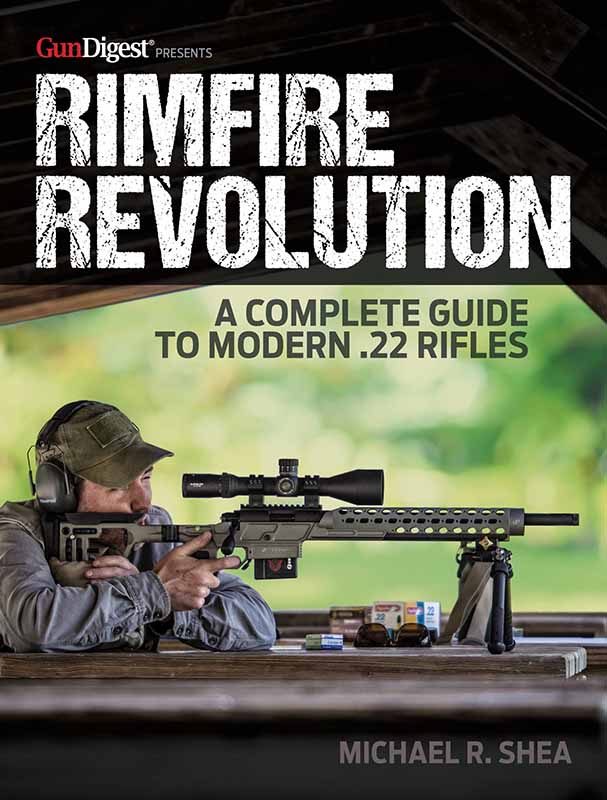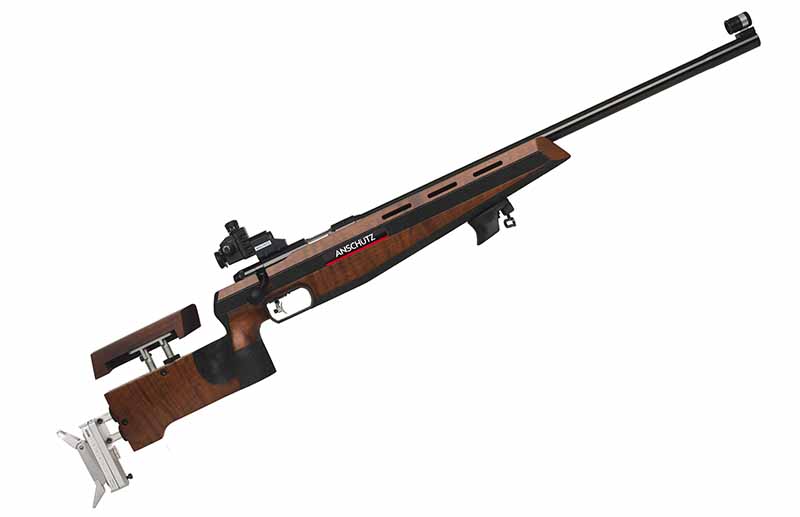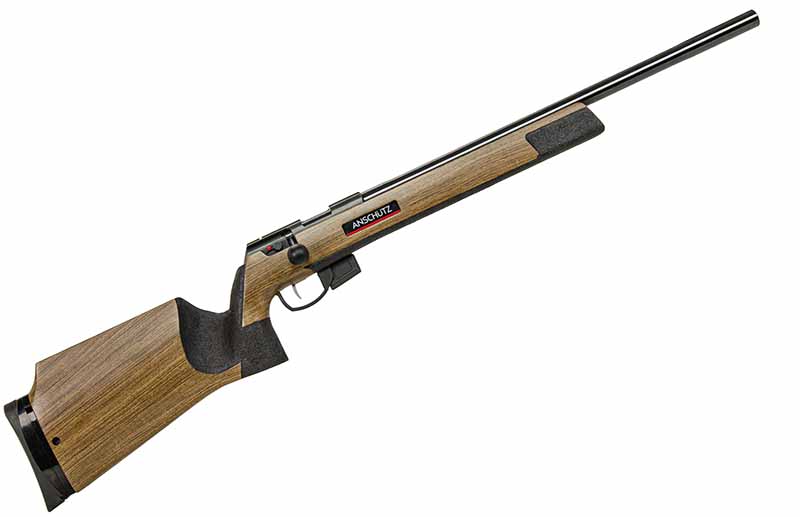
Few rimfires beat the Anschütz rifle, but nailing down the specifics between models can prove a bit tricky.
What Are Anschütz Rifle Actions:

Considering current production rifles, slices its lineup in three ways: Hunting or Sporting, Target, and Biathlon. Sporting lineup variations through Anschütz North America include the Meister Grade Series with premium walnut stocks and the Canyon Creek Series with super-premium walnut. These rifles are largely magazine-fed repeaters. The Target rifles are geared toward Olympic-style positional shooting and benchrest and are primarily single shots. Anschütz has been slow to move into the NRL22-style precision market. Still, there are Custom Shop options — magazine-fed trainers available in laminated GRS stocks and a Rimfire Trainer Series in an XLR chassis. Think of Anschütz in broad categories of Sporting, Hunting, and Biathlon, but the real differentiator model to model is the action.
Anschütz has five primary rifle actions: the foundational Match 54; the variant 54.30; the practical and recently discontinued 64; the new swap-barrel 1761; and the straight-pull Fortner biathlon action. Anschütz has been deliberate over the years in its designs. Each action serves a purpose and serves it well.
54 Action

The Model 54 is effectively a three-lug design with a bank vault-strong lock up. There are two rear locking lugs on the solid steel bolt, plus the bolt handle’s lapped base that acts as the third lug. There is a short 53.5-degree bolt lift with a famously glass-slick raceway. The light firing pin travels less than 2 centimeters, which gives the 54 one of the fastest lock times in rimfire. The receiver is thicker and heavier than other actions in the Anschütz line and most rimfire actions in general, at least until the recent rise of centerfire-inspired Remington 700-footprint actions. This oversize makes a good support for heavy contour barrels. Most barrels are press fit with a dual retaining pin.
There are repeater and single-shot versions of the 54 action. The repeater magazines are a curved single-stack similar to a CZ mag. There are several trigger options, but the benchrest-quality two-stage 5018 is perhaps best regarded. It’s fully adjustable with a pull weight range of 2.1 to 8.6 ounces. I suspect the Model 54 with 5018 trigger is the winningest match receiver/action combo in smallbore history due to its long dominance across multiple disciplines. (The Winchester 52 may be close due to its long successful run. I have no data to support this either way.) But it is undoubtedly true that the 54 action and its excellent triggers put the Winchester and Remington 40x out of business at the elite shooting level almost overnight. The short bolt lift, lock up, lock time, and premium Anschütz rifle barrels came to define peak rimfire
accuracy.
Current production 54 action rifles include the single-shot 1907, 1913, and 2013 match rifles. You can think of the 1907 barreled action as a lighter version of the 1913 with a slightly smaller barrel diameter. The 2013 action is an updated variant of the Match 54 single shot with an extended and squared bedding area and clamp-style barrel attachment. Anschütz uses the 54 action in the 1710 and 1712 sporter rifles. For silhouette and modern precision, shooting the 17xx line is the most widely used of the 54s.
54.30 Action

In 2015, Anschütz updated the single-shot 54 action with the 54.30. It moved the loading port rearward 30 millimeters, hence the 54.30, which reduced the overall action length by 18 percent. This change made the action stiffer and lessened the movement required by positional shooters to cycle it. The revision further lightened the firing pin for an even faster lock time. The 54.30 also has a threaded receiver and barrel connection, and it cut barrels with a new-to-2015 proprietary Anschütz match chamber. Not only that, the rounded footprint matches that of the 1907 and 1913. Depending on the stock, these positional rifles run between $4,700 and $5,500. That is a lot of money but represents almost a bargain compared to Bleiker, Feinwekbau, and other exalted European rifle makers, which can cost two or three times as much.
64 Action

The 64 action rifles are what most Americans think of when they think of an Anschütz rifle. For a long time, Savage imported them as Savage-Anschütz, and they’re all over the used market in .22 LR and .22 WMR. Newer version 64s — not imported by Savage — can be found on the used market in .17 HM2 and .17 HMR. The rifle that kicked off my obsession with rimfire was an Anschütz 1502 with the 64 action in .17 Mach 2. (You could blame this whole book on that rifle.) Anschütz discontinued the 64 in favor of the newer 1761 action. According to Steve Boelter, president of Anschütz North America, it received the last U.S. shipments of guns and service parts in December 2020. Shooters with 64s should not worry about future parts availability. “We have enough ejectors and firing pins to last a century,” he told me.
The 64 action is a scaled-down lightweight version of the 54, which suits sporter rifles and small game guns. The one-piece solid steel bolt body has no lugs. The locking surface is the base of the bolt handle. The 64 has a different trigger system, and while there are many good ones — Anschütz does not make a lousy trigger — there is no trigger model for the 64 that equals the two-stage 5018. The 64 and 54 are two different footprints, so stocks and triggers are not interchangeable between the two actions. The 64 barrels are press fit with one horizontal locking pin. The magazine release is less than ideal for position or bench shooting, but there are extended aftermarket options available to correct that. There was also a run in the 2000s where every new 64 seemed to have ejection issues. The case would eject slowly and often tumbled into the open receiver port. Engineers corrected this with a new ejector, and for a while, Anschütz sent them out for free or did the work themselves if you mailed them the bolt.
People ask, “What is more accurate, the 54 or the 64?” Mechanically, the 54 may have more accuracy potential with its heavy-duty build, locking lugs, and faster lock time. It certainly requires more hand finishing work and is a premium action. The barrels are made the same way, on the same machines, of the same or similar contours, with the same chambers. The 54 is a more sophisticated and expensive action, but to call it more accurate? Well, it depends. There are less-than-perfect 54s and barn-burner 64s, as is the nature of factory-built rifles. On average, the 54 series is more so a precision instrument. It has more potential as an accurate rifle system, but I’ve yet to shoot a 64 or know anyone who has one and complains about poor accuracy. The universal question on rimfire forums is always, “Is this rifle more accurate than that rifle?” The answer is almost always, “It depends.”
More Rimfire Info:
- Best .22 Ammo For Every Application
- The .22 LR: Mini, Mighty And Many
- The .22 LR And Its .22 Rimfire Cousins
- Cartridge Debate: .17 HMR vs. .17 WSM
- Ammo: Evolution of the Red-Hot .17 HMR
- The .22 LR For Self Defense: Good, Bad Or Crazy?
1761

The newest Anschütz action, the 1761, has a host of modern features and has been designed to replace the 64 as a light, all-purpose, and relatively cost-effective platform. What started as a rework for the 1710 and 1712 Match 54 repeaters became a total redesign. As Anschütz put it in a good explainer on its North American website:
“…we opted to slightly increase the bolt lift from 53 to 60 degrees as a trade-off in order to move the locking lugs from the rear to the middle of the bolt. The lugs were switched from smaller eccentric lugs to a much more robust set of three lugs and evenly spaced these around the bolt. This allowed us to move from a long dual-spring firing pin to a very short, light firing pin and single-spring striker system. The new spring and striker mechanism was moved to the rear half of the bolt. This change also made the bolt much shorter in overall length.”
The bolt’s back is a roller bearing, making the opening motion smoother with less required force. The dual ejector system borrows from the single-shot Match 54. Ejectors are held in place by plunger and spring rather than c-clamp.
The smooth barrel tenon slip fits in the receiver like a CZ, but with one key difference: Rather than grub screws directly tensioning the tenon, there are two small v-blocks that Anschütz says more evenly distribute pressure and don’t mar the tenon. Shilen, Lilja, Lothar Walther, and other quality barrel makers produce drop-ins.
The steel billet receiver is CNC machined with an integral recoil lug and square bottom bedding surface. The action has square lines, not the rounded body of more traditional Anschütz rifle actions. It is 4 centimeters shorter than the Match 54 action (read: very rigid) and held down in the stock with two action screws. There is an 11mm dovetail rail on top. Anschütz opted not to tap it, which is a mistake. (The best Anschütz rings, according to many, including me, are the one-piece Talley rings and bases for the tapped receiver, not the more common 11mm dovetail clamp-style rings.)
The magazine is a steel and poly combo. As of early 2021, there were only 5-rounders, though a 10-round prototype has moved toward production. The small radiused hinge release button is behind the magazine and accessed through a cutout in the triggerguard. You can drop the mag with a forward slap of the trigger finger. The triggerguard is an unfortunate plastic, but steel models are available on the aftermarket. Calibers include .22 LR, .17 HMR and .22 WMR.
Fortner Action

Peter Fortner invented the straight-pull action that bears his name, and he still manufactures them in a small shop in Rohrdorf, Germany. Under a licensing agreement, his entire run of rimfire actions goes to Anschütz, which builds them into its flagship biathlon guns and the 1727 F line of sporting rifles in .22 LR, .17 HMR, and .17 Mach 2. Fortner also designed a centerfire equivalent for German rifle builder Heym. Boelter likens the Fortner relationship with Anschütz like a speed shop within an auto manufacturer, AMG within Mercedes.
Straight pulls operate faster than classic turn bolts, with less motion required to cycle them. Rather than the four movements of lifting the bolt, pulling it back, and pushing it forward, then pushing it back down again, there are just two motions to a straight pull: rearward and forward. Shooters typically run them with their thumb on the back of the bolt.
After the shot, the trigger finger comes up and cycles the bolt rearward. Then the thumb pushes it home on the fresh round. Much of Europe has outlawed semi-automatics, so when speed is needed, as in biathlon events or boar hunting dense forest with centerfires, straight pulls have proven fast and accurate. That explains why Anschütz, Heym, Blaser, and others have cultivated the design. Straight-pull actions have mostly gone unnoticed in the US of A. That’s because 1. we have all the guns, and 2. the cost. Straight pulls are necessarily complicated and expensive to make. The exceptions on this side of the pond are the Browning T-bolt and the Savage Impulse.
The Fortner action uses seven ball bearings that act like rear locking lugs. The action works very much like a hydraulic tractor hose or an air tool connection. When you put pressure on the bolt handle, it relieves stress on the bearings that sit within the sleeved bolt. This movement withdraws the ball bearings into the bolt, and you can cycle the action. The handle is spring-assisted, so the balls extend out and into the recesses in the receiver body and lock up when it snaps forward. This design allows for a linear rather than a rotating bolt action. Pulling the handle acts like pulling the collar on a quick-connect hydraulic line. It retracts the bearings and breaks the connection. Compared to a semi-automatic rimfire, this creates a stronger lockup. Advocates say they can run the bolt accurately almost as fast, too. Well, maybe. What is certain is the design is effortless to run. A broken-in Fortner seemingly wants to cycle itself with just some encouragement from forefinger and thumb. The Fortner action is rounded with a floating ring recoil lug and press-fit, two-pin barrel connection and comes with the world-class 5020 two-stage trigger with a pull weight range of 3.1 ounces to 1.375 pounds. Biathlon rifles come set at the required 500 grams or 1.1 pounds. The total package is a remarkable feat of firearm engineering.
For more information on Anschütz rifles, please visit anschutznorthamerica.com.
Editor's Note:This article is an excerpt from Rimfire Revolution: A Complete Guide to Modern .22 Rifles, available at GunDigestStore.com.

Next Step: Get your FREE Printable Target Pack
Enhance your shooting precision with our 62 MOA Targets, perfect for rifles and handguns. Crafted in collaboration with Storm Tactical for accuracy and versatility.
Subscribe to the Gun Digest email newsletter and get your downloadable target pack sent straight to your inbox. Stay updated with the latest firearms info in the industry.

![Best Concealed Carry Guns In 2025 [Field Tested] Wilson Combat EDC X9S 1](https://gundigest.com/wp-content/uploads/Wilson-Combat-EDC-X9S-1-324x160.jpg)


![Best 9mm Carbine: Affordable PCCs [Tested] Ruger Carbine Shooting](https://gundigest.com/wp-content/uploads/Ruger-Carbine-Shooting-100x70.jpg)
![Best AR-15: Top Options Available Today [Field Tested] Harrington and Richardson PSA XM177E2 feature](https://gundigest.com/wp-content/uploads/Harrington-and-Richardson-PSA-XM177E2-feature-100x70.jpg)
